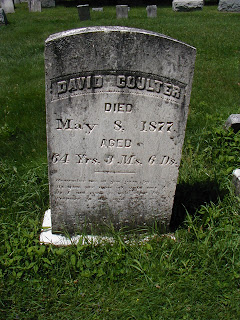So who was the first soldier from Bovina to enlist in the Civil War? One of the earliest Bovina enlistees for whom we have documentation is
William Stott, son of Walter and Mary Stott of Bovina. He enlisted on August 19, 1861, joining Company F of the 3rd New York Calvary. William became one of the eleven Bovina boys who died in the war, dying in action in May 1864. Joining the 3rd Calvary the same day were were brothers
Robert P. and
Daniel D. Tompkins, nephews of Robert Post of Bovina. The brothers were from Roxbury but were living with their uncle (or at least claiming their residence there) at the war’s end. It is not clear how long they actually lived in Bovina, but they are listed among Bovina's Civil War soldiers.
In October 1861, four Bovina men would join the 8th Independent Battery.
Robert White joined on October 2, but would be discharged for disability less than a year later. Three men joined the battery on October 11.
Darius Hadley, like White, also would be discharged for disability in February 1863. His disability arose from wounds received in battle the previous May.
James K. Mills joined the same day as Hadley, but unlike Hadley and White, would serve the entire war in the battery, mustering out June 30, 1865.
Edgar Seacord served his three years and mustered out October 28, 1864 in Norfolk, Virginia.
The last enlistment from Bovina in the war’s first year appears to be
Charles Wycof. On December 12, 1861, he enlisted in the 72nd Infantry Regiment, company L. He transferred twice within the regiment and was discharged for disability on May 1862. From here, the record gets confusing. Some sources state he re-enlisted in the 144th, but there is no record of such service. There is a receipt dated November 15, 1863 for a bounty payment of $140 from the Town of Bovina made to Wycoff. Was this a long delayed payment for his 1861 enlistment or for the re-enlistment? The document doesn’t provide that information.
There were some Bovina soldiers who enlisted even earlier, though at the time of their enlistment, they were not Bovina residents.
Edward Kennedy, who lived in Lake Delaware in 1890, enlisted in New York City on April 27, 1861. He started in the Fourth New York Volunteers, mustered out in May 1863, then appears to have re-enlisted in December of that year in the 16th Artillery. Kennedy deserted in February of 1865, though he later was able to collect a pension.
Samuel Bouton, who was born in Roxbury, enlisted on May 16, 1861 in the 8th Pennsylvania Infantry for three months. By 1863, he shows up in Bovina's list of draft registrants, but he appears to have had no further service beyond the three months with the 8th Pennsylvania. He married Mary Ann Gillie in Andes in 1864 and they settled in Lake Delaware, where he died in 1912. He was buried in Bovina.
James W. Clark’s Bovina connection came late in life. Born in Hamden, he was living in Delhi with his wife and children when he enlisted in the 72nd Infantry on June 4, 1861. Clark mustered out three years later. He lived in Delhi after the war but by the 1880 census was living in Downsville. In 1900, he was living in Bovina in 1900 with his son-in-law and daughter. Clark died in Bovina in 1902 and is buried there.
James McNair is another Civil War soldier with a tenuous connection to Bovina. His Bovina connection appears to be solely that he was enumerated with his uncle, Walter Doig in the 1865 census. He enlisted December 20, 1861 in the 8th Independent Battery. He re-enlisted after his three year stint ended and mustered out with the battery on June 30, 1865.
As the Civil War dragged on, more and more Bovina soldiers would enlist. The last enlistments from Bovina took place in September 1864. One of those was
William R. Seacord. He was drafted in 1863 but was excused because his brother Edgar, one of Bovina's 1861 enlistees, was serving. Edgar was discharged in October 1864. About a month before, apparently learning that his brother was to be discharged, William enlisted in the 144th. He was mustered out nine months later. At the war's end, over 60 Bovina boys had served in the war.
Note: On November 6, I will be doing a presentation at the Delaware County Historical Association’s annual meeting about finding Delaware County’s Civil War soldiers – “Rally Round the Flag, Boys! Finding Delaware County's Civil War Soldiers.” The event starts at 1 pm with the Annual Meeting, Pot Luck Lunch and Award of Merit presentation. To attend the Pot Luck Lunch, please bring a side dish or desert to pass. Ham and turkey will be provided. My presentation starts at 2:45pm. You are welcome to simply come at that time for the presentation. Admission is free.
















